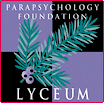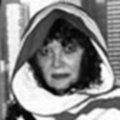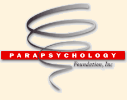 |
 |
| THE BIOGRAPHICAL DICTIONARY OF PARAPSYCHOLOGY MICHAELEEN MAHER This autobiography was written for the PF Lyceum Blog #11, “Lives in Parapsychology.” A more formal biography will be posted in the coming months. Michaeleen Maher  Curiosity is probably the main reason I became a parapsychologist — curiosity about life, about my experiences, about the universe itself. Some of us aren’t content to accept the established dogmas passed along to us by our cultural institutions and faiths, and I guess I was one of those rebels. I always asked too many questions in school, and often the answers were neither satisfying nor gratifying. Curiosity is probably the main reason I became a parapsychologist — curiosity about life, about my experiences, about the universe itself. Some of us aren’t content to accept the established dogmas passed along to us by our cultural institutions and faiths, and I guess I was one of those rebels. I always asked too many questions in school, and often the answers were neither satisfying nor gratifying.
When I was growing up, science, as it was taught to us, did not admit of unlimited mystery. Science was more pragmatic than that. It was assumed that everything, in principle, could be known, and it would all fit nicely into what we already knew — it was just a matter of time. Plodding gamely forward on the same old path that everyone else had taken was the way to make progress. Fit in. Don’t make waves. That was always the subtext in school. If you expected to make out in life and enjoy a prosperous career, thinking inside the box was the way to go. I dropped out of college after a couple of years to travel and see the world, and the first place I went was India, because India represented the unknown. The seers of India were reputed to have arcane knowledge and secret occult powers that transcended anything we Westerners — trapped in our nouveau culture — had ever confronted. Was it true? That’s what I wanted to know. I traveled for two years throughout the length and breadth of India, and if it was mystery I wanted, there was plenty there. I sat at the feet of gurus from Calcutta to Kerala, and I had many other adventures besides. The main thing I encountered, which serves as a leitmotif for the Oriental mindset, was a tolerance for ambiguity. Though gurus were keen to convey their wisdom and demonstrate their supernormal skills, it was the process rather than the prowess that kept their legends going. The awe, reverence, and willingness to believe amongst the multitudes of disciples meant that miracles were always in the making. Perception was the key. Whatever transpired was irreducibly embedded in the context, and the context was grand. This meant that a guru’s exploits, no matter how modest, would mushroom into vast proportions before a day had passed. Miracles were inevitable, because the observers willed them so. That said, did I witness anything that I, with my logical Western mindset, regarded as indisputably paranormal? Maybe once or twice. Frustrated by the ambiguity that seemed to bother no one else but me, I gained a fresh appreciation for the virtues of the scientific method. Careful testing, it seemed, was imperative before any miracles could be proclaimed. Yet there were obviously many obscure phenomena that science wasn’t paying any attention to. All my life I had experienced what could be called “garden variety psi” — knowing something before it occurs; having an ominous foreboding when danger is on the horizon; encountering unfathomable “synchronicities.” Before leaving India, I lived in a cave for awhile, and my own clumsy efforts to achieve nirvana brought me out-of-body experiences and paranormal dreams. So for me, life had always been rich with phenomena that Western science didn’t even entertain. In its pursuit of truth, science was definitely missing something. I returned to the States, got married, and had two wonderful children. While living in a cabin in the Berkshire Mountains, I remember sending away for a copy of the Journal of the Society for Psychical Research. I was very excited when the journal arrived from England, but when I tried to read it, I was dumbfounded. All of the statistical computations seemed like gibberish to me, and I hadn’t the slightest idea what the authors were talking about. I just didn’t have the educational background to make any sense out of what I was reading. An opportunity presented itself to continue my education at The City College of New York. As I surveyed the course list being offered that spring, one course, “parapsychology,” caught my eye. It was being taught at City College for the first time, though the professor, Gertrude Schmeidler, had been brought to the university decades earlier, explicitly because of her interest in parapsychology. It turned out that Gardner Murphy, the distinguished psychologist who set up the psychology department at City College, was a notable parapsychologist on the side, and he had offered a professorship to Gertrude. I sat in on one session of the new course before signing up, and I was captivated by this demure little woman, who spoke so sensibly and lucidly about research efforts underway to explore the very phenomena I felt science had been ignoring. It was music to my ears. Before the parapsychology course was over, I had designed and conducted my own experiment, and I’ve been a parapsychological researcher ever since. When I finished my BA, Gertrude offered me a fellowship to obtain a PhD doing research in parapsychology. The stipend would come from an educational fund that had been given to her by Chester Carlsen, the inventor of the Xerox machine. My PhD program in cognitive psychology was primarily concerned with brain research, so I devised experiments that explored how psi worked in the human brain. My dissertation experiment showed that the brains of ordinary persons left indisputable traces of psi activity, and that the effects were essentially global, rather than particular. That is, clairvoyance was operating at the grass roots level of neuronal firing, but rather than the participant having a couple of isolated thoughts that resembled the remote target (in this case a videotape), it was the whole play of thought, the entire complexity of thought, that corresponded to the target more than it ought to have done, in the absence of any psi. And no matter which way you looked at the data, the imprint of global psi was there. I was blown away by the results, and I eagerly looked forward to an exciting career in parapsychology — plumbing the depths of brain activity to root out manifestations of psi, and thereby peeking further into the universal mystery of the mind. That’s when the down side of our impoverished, underfunded field kicked in. The one brain research parapsychology laboratory, at Duke University, was in the midst of folding. Other parapsychology labs that had been flourishing in the U.S. during the nineteen-seventies and early eighties — primarily due to the largesse of McDonald, of McDonald-Douglas Aircraft, who gave them generous research grants until he died — fell on hard times and closed. I could no longer conduct my experiments at City College, because I had already graduated, so I put brain research on the back burner and took the only job in parapsychology that was available to me. I became the librarian at the American Society for Psychical Research. I loved working there, browsing through the society’s phenomenal collection of books and journals in order to answer research questions from the public and the media. It wasn’t long before I was designing an experiment that could be conducted at the society, using visitors to the library as my volunteer subjects. I confirmed a fascinating new effect with this research — there was a sort of crystallization of the “meaning” of psi content over time, so that blind judges matching psi mentation reports to their targets got better at it as they repeated the task. Things were really bubbling along in my chemistry flasks when suddenly, the society was caught in a severe budget crunch and the librarian position was discontinued. It’s evident that to have a career in parapsychology, you have to be versatile and roll with the punches. So that’s what I did. Shortly before the leaving the society, I had been approached by a TV producer who had an award-winning show, WomanWatch. This was a series on women with unusual occupations, and she wanted to feature a parapsychologist. She would depict me mainly at my job as the ASPR’s librarian, but she asked if I had any hobbies she could film, to add further dimension to the piece. I had already investigated the report of a ghost while I was in graduate school, so I suggested she film a ghost experiment, but I told her she would have to locate a suitable ghost. She loved the idea. She assigned her production assistant to research hauntings in the greater New York area, and the production assistant came up with a fascinating case. Ever the experimentalist, I set about designing the research in such a way that it could be filmed without contaminating the experimental data. If I was going to get involved, I wanted to make sure I got some serious data out of it. The project went off without a hitch, and soon other TV producers began calling, and talk show hosts as well. This launched me into the spotlight as a scientific “ghostbuster.” Frankly, I was always more interested in the research data than the TV appearances, so I began using the TV producers to fund new ghost research. Years later, when I felt I had taken my ghost experiments as far as they could go, I published a meta-analysis that combined the results of all of my major studies. Leaving the experimental results tucked in the journal report for posterity, I pretty much closed the book on ghost hunting and began turning TV producers down. Based on my brush with TV superstardom, I suppose you could say that glamour is another component of being a parapsychologist. In some sense, itís what you call a “sexy” field. People are generally intrigued when you tell them you’re a parapsychologist. Even conventional scientists, depending on their orientation, can be interested in discussing your research results with you. And if you should happen to be an articulate spokesperson, and have a flair for public relations, there may be untold opportunities to advance the field’s agenda by skillfully (and lucidly!) conveying our research findings to the public through the media. Parapsychology badly needs such ambassadors. But one thing you have to appreciate if you’re contemplating a career in parapsychology: Financial security is not one of the perks! If you’re “into the material world,” you’re better off going into some other field. And even if you do choose to make parapsychology your life’s work, you should know that parapsychologists find themselves earning a living outside of the field more often than not. Teaching parapsychology courses at a local university is one way to keep a professional foothold, but I’ve often had to augment my adjunct professor’s salary by doing freelance editing work for major magazines. Yet few careers, in my opinion, offer the intellectual gratification and pure excitement that parapsychology does. If scientific discovery is your goal, you can be a pioneer venturing into territory that’s never been explored before. If you’re good, you can make a name for yourself and get your research published more easily than in other fields. Our community is tiny, so individuals tend to be more conspicuous. And though the field is impecunious, and it drifts in and out of favor with the public and the media, thereís usually some modest funding that can be dredged up for purposes of pure research. For example, in 1992 I received a grant that enabled me to travel to Russia to conduct experimental research in healing at a brain research lab in St. Petersburg. In our field, you generally get to pursue your intellectual passions, no matter what. Maher, M. C. (1999). Riding the waves in search of the particles: A modern study of ghosts and apparitions. Journal of Parapsychology, 63, 47–80. Maher, M. (1986). Correlated hemispheric asymmetry in the sensory and ESP processing of ‘emotional’ and ‘nonemotional’ stimuli. European Journal of Parapsychology, 6, 217–257. Maher, M. C. (1986). Replication of an “incline” effect in blind judging scores. Proceedings of The Parapsychological Association 29th Annual Convention, August 5–9, 383–398. Maher, M. C. & Hansen, G. P. (1995). Quantitative investigation of a “haunted castle” in New Jersey. Journal of the American Society for Psychical Research, 89, 19–50. Maher, M. C., Vartanian, I. A., Chernigovskaya, T., & Reinsel, R. (1996). Physiological concomitants of the laying-on of hands: Changes in healersí and patientsí tactile sensitivity. Journal of the American Society for Psychical Research, 90, 77–96. |
 |

|
 www. parapsychology. org |
||